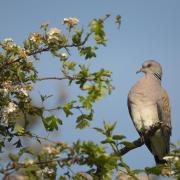Find out what inspires the President of the Rochester and West Kent Art Society
Roy Sparkes, President of the Rochester and West Kent Art Society, has been painting all his life, moving gradually from landscape into abstract.
Highly literate in art history, as a result he tends to dismiss the language that is typically used to describe painting.
When I comment that his work is modernist, its concerns dealing self consciously with the paint on the canvas, he tells me: “There are nonsense words used to describe paintings: I would prefer they were called ‘real’ paintings.”
Modern, he says, is a time appellation and once a painting is done, it is in the past.
Roy has been in Kent since 1974, moving down from Crayford. He says that the people are the great thing about this county and after that, it’s the landscapes and the way the light changes from place to place.
“Take the Marshes, for example,” he says. “The light is more embracing. In the Medway, the light is more challenging; there are microclimates everywhere.”
Inspiration is, however, highly subjective and as Roy tells me: “You can’t just put a finger on it; the inspiration is what happens when you get up, on the day. It can change almost immediately.”
His works are mostly landscapes that span Kent’s countryside and seascapes. One of Roy’s proudest achievements was when he was commissioned to create a series called the Medway Set. These were often based on oil pastel sketches, undertaken en plein air, just like the Impressionists of old.
Describing a series called Coastline as “starting points for recent paintings,” Roy adds: “Visual experience is the main ingredient of a complex recipe.
“Qualities of colour and texture have invited exploration of hidden depths that I have tried to express in the sense that the intrinsic qualities of a coastline and of a painting are inseparable from their poetry.”
Roy also expresses his wish to explore the nature of transience in human experience and the interaction between memories, thought and imagination.
In the Medway Set, for example, use was made of photographs and memory in addition to the sketches.
His more recent work is essentially abstract, studies in colour, often bright in palette and texture and highly attractive, with titles expressing antinomies, paradoxes and contradiction, such as Transience and Resilience.
In these works, highly textured colour is set next to a block of plain paint in order to highlight but merge in a contrasting dichotomy. It is as if we are looking at Rothko tipped up sideways.
I also look at a book of Roy’s drawings and see here reminiscences of Duchamp (Nude Descending the Stairs) and the colour tonalities of Ivon Hitchens, the British landscape artist.
Roy loves the concept of abstract painting. He tells me: “It’s far more difficult. You have nothing to refer to; you are on your own. Your memories may come through. You have nothing bar what is in your head and your being.”
His love for the abstract also transfers into other mediums. He is not just art- literate, but also a lover of literature. Not surprisingly he writes poetry and also says that some of his influences include Diderot, Camus, Kundera, Vargas Llosa, Canetti, Paz and Flaubert: highly eclectic, then.
I am intrigued about the materials Roy uses. Since abstract doesn’t have to conform to any substantial rules, anything an artist can get his hands on may be used to achieve a satisfactory end product.
Roy mainly uses acrylics, although oil is “the one medium that satisfies my senses more, it almost has a taste.”
Watercolour is no longer of great interest to him, as he feels he has come to the end of exploring this medium: he would buy very expensive paper to experiment with watercolour and notes that it is a wonderful experience to pursue it for its own sake.
Asked to cite his most exciting work Roy says, “They are all my babies. The new baby is always the favourite one.
“However, perhaps it’s the Medway Set. There are a small number I would never part with. I don’t actually paint to sell; I do it because I have to.”
This drive is what may also inspire young artists, and Roy’s advice to them is: “Always remain true to you. Never try to copy someone else’s work.” n



























